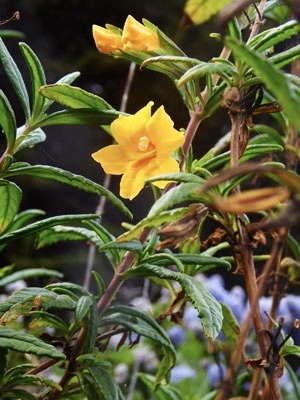
Drought-tolerance
As California's drought continues, many gardeners are looking for water-sipping plants that are better suited to the dry climate. Drought-tolerant native plants offer distinct advantages over non-native drought tolerant species, as they may be easier to establish in our areas. They often require less water, provided they are planted in a location that is relatively similar to their native environment.
Here are some drought-tolerant plants that are also great ornamentals:
- Plants in the Asteraceae family, like Symphyotrichum chilense (California Aster), are drought tolerant as well as beautiful. This fall-blooming plant is well-liked by butterfly colonies that migrate to the coastal areas in the autumn season.
- Salvias are also noted as drought tolerant: Salvia mellifera (Black sage) and Salvia columbariae (Chia sage) are pretty plants that do well in low-water conditions.
- An often overlooked drought tolerant native plant is Mimulus aurantiacus (Sticky monkeyflower). Also nice is M. aurantiacus var. puniceus (Red monkeyflower) which is the red version of this little gem.
Choose wisely
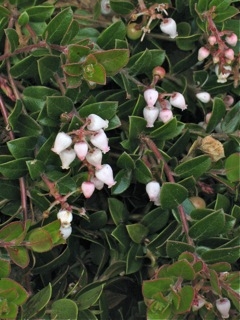
- Areas with soils containing large amounts of decomposed granite (DG) should be amended with firbark or a component with similar properties to improve aeration and drainage.
- Plant a little bit high - don't bury the base of the stem.
- Irrigate new native additions regularly (approximately 1-2 times per week to monthly) during the first few summers.
- Fertilizers are rarely needed (although there are some exceptions) and new transplants of most species will be enhanced by dressing the area surrounding the crown with mulch to ensure roots aren't expose and with the occasional top dressing of compost.
- Water in after planting, even if rain is expected. Watering in will help soil settle around roots and remove air pockets.
- If you are near within a few miles of wildlands, do not plant cultivars of native species to prevent hybridization with local natives.
When you do find plants that work in your area it is a wonderful way to feel connected to nature, whether you're experiencing it in a park, in your landscaping, or in a container garden.
Pollinator-friendliness
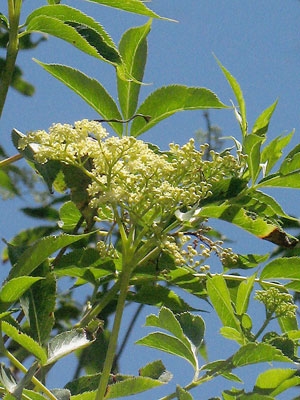
- Ceanothus thyrsiflorus var. griseus (Carmel ceanothus) and the clonally propagated C. ‘Ray Hartman' are among those visited by the European honey bee
- Arctostaphylos spp. (Manzanita) is a shrub well known to attract hummingbirds, butterflies, as well as cutter and bumble bees.
- A third amazing native pollinator plant is Sambucus sp. (Elderberry). Two examples originating from the Monterey Bay include S. nigra (Black elderberry) and S. nigra ssp. caerulea (Blue elderberry). Elderberry plants are a favorite of butterflies, hummingbirds and many bees.
- More pollinator-friendly plants that originate from the Central Coast include:
? Eriodictyon californicum (Yerba santa)
? Clinopodium douglasii (Yerba buena)
? Frankenia salina (Alkali seaheath)
? Arctostaphylos crustacea ssp. crustacea (Brittle leaf manzanita)
? A. edmundsii (Little sur manzanita)
? A. hookeri ssp. hookeri (Hooker's manzanita)
? A. pumila (Sandmat manzanita)
? A silvicola (Silverleaf manzanita)
? Ceanothus cuneatus var. ramulosus (Buck brush)
? C. rigidus (Monterey ceanothus)
? Eriogonum nudum (Nude buckwheat)
? Clarkia unguiculata (Elegant clarkia)
? Epilobium canum (California fuchsia)
? Frangula californica (California coffeeberry)
? Penstemon rattanii (Rattan's beardtongue)
? Solidago velutina ssp. californica (California goldenrod)
Health and nutrition
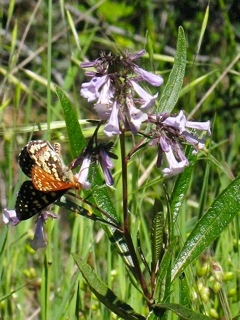
Native plant online resources
The number of amazing native plants in our area can be a bit overwhelming and you may wonder where to start. There are many great opportunities to connect and learn about native plants in our area. The California Native Plant Society (CNPS) has a chapter in Santa Cruz that meets bi-monthly at the UCSC Horticultural building and Monterey and San Benito Counties' chapter meets bi-monthly at the Pacific Grove Museum of Natural History. For those living in the Monterey area, you can visit the Return of the Natives group each Tuesday from 10:30-12:30 at the Watershed Institute of CSUMB. CNPS and the Jepson Herbarium partnered on a great website with a native search tool to make it easy to find native plants in your area. In addition to local nurseries specializing in native plants, there are several native plant sales offered in the fall by organizations that support native plant research. Here are a few to watch for!
Upcoming native plant sales
- Elkhorn Slough Reserve: The Elkhorn Slough Reserve has an Open House and Native Plant Fair on September 24th from 10am-2pm.
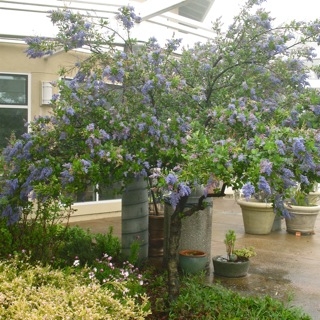 Ceanothus 'Ray Hartman.' Photo: © Carol Nickbarg
Ceanothus 'Ray Hartman.' Photo: © Carol Nickbarg - Monterey Bay CNPS: The annual plant sale is Saturday, October 1st from 10am-1pm at MEarth Hilton Bialek Habitat at Carmel Middle School.
- Watsonville Wetlands Watch: Saturday, October 1st, 9am-3pm, Watsonville Wetlands Watch hosts their 4th annual Habitat Festival and Native Plant Sale.
- Santa Cruz CNPS - UCSC Arboretum: This year's fall plant sale will take place on Saturday, October 15th. Members of the CNPS and UCSC arboretum gain early admission from 10am-12pm, while the sale opens to the public from 12-4pm
References used in this article
Several online and print references were utilized for this article. Citation information follows:
- California Native Trees and Shrubs For Garden & Environmental Use in Southern California and Adjacent Areas. 1981. Lee W. Lenz & John Dourley. Claremont, California Rancho Santa Ana Botanic Garden.
- Culpeper's Complete Herbal. 1995. Nicholas Culpeper. Wadsworth Editions, Ltd. (Originally published in 1653)
- www.botanical.com - A Modern Herbal, Mrs. M Grieve, online version
- A Modern Herbal. 1992. M. Grieve. Dorset Press (Originally published in 1931).
- CNPS.org
Additional references on California native plants
Many additional print references exist for native plants. Following is a selection of a few used by members of the Native Plant Subject Group:
- California Native Plants for the Garden. 2005. Carol Bornstein, David Fross & Bart O'Brien. Cachuma Press.
- Complete Garden Guide to the Native Perennials of California. 1990. Glenn Keator. Chronicle Books.
- Complete Garden Guide to the Native Shrubs of California. 1994. Glenn Keator. Chronicle Books.
- Designing California Native Gardens: the Plant Community Approach to Artful, Ecological Gardens. 2007. Glenn Keator, Alrie Middlebrook & Phyllis Faber. University of California Press.
- Wild Lilies, Irises, and Grasses: Gardening with California Monocots. 2004. Nora Harlow & Kristin Jakob (eds). University of California Press.
Attached Files:
